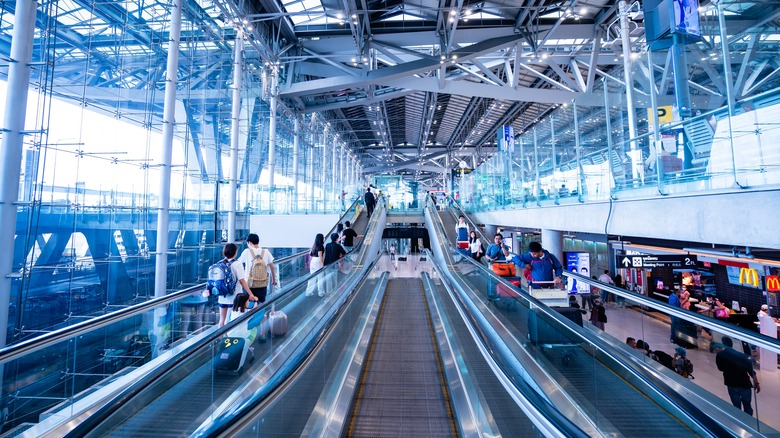The Scary Reason Travelers Need To Be Cautious Of Moving Walkways At The Airport
More often than not, airport safety tips focus on points like protecting your carry-on luggage from thieves, blending in with the crowds, or avoiding taxi scams. However, while you're clutching your bag and researching your ride to the hotel, a hidden danger might be lurking just under your feet.
Moving walkways, sometimes called "travelators," are common in airports and offer a dual purpose. For those rushing to make their flight, a moving walkway theoretically helps speed up their steps, especially in long hallways between terminals. For tired fliers, mechanical walkways make it possible to get from one point to another without having to move a muscle.
While moving walkways offer convenience, they can be risky if not used correctly or if the machine malfunctions. According to an article by lawyer Michael Ehline, serious injuries are most likely to occur when a person falls on a moving walkway or gets their clothes or body parts caught in the machinery. And these aren't just hypotheticals—some unfortunate travelers have experienced these dangers firsthand.
Moving walkways in airports don't always work as intended
Injuries on moving walkways might be rare, but they aren't unheard of. In 2024, a woman in Shanghai fell through a broken walkway and remained trapped for half an hour before being successfully rescued. Though the incident took place in a supermarket, it also reminds us how hazardous airport walkways can be, especially when you're in a hurry or too jet-lagged to notice a defect in the conveyor belt.
Earlier in 2024, the motorized machines also made headlines after a pilot filed a lawsuit claiming a moving walkway at Denver International Airport left him with severe pain. Court documents obtained by USA Today stated that the pilot's foot got caught in a moving walkway that was missing a floor plate, leading to bone contusions and other injuries.
In a more severe accident, a woman got caught in a Bangkok airport walkway in 2023, resulting in the amputation of her leg at the knee. An official investigation later revealed that one of the walkway's plates detached, causing the woman to fall into a gap.
Should you avoid moving walkways when traveling?
There is little data available on walkway-related injuries. However, a 2013 study published in the Western Journal of Emergency Medicine revealed that roughly 10,000 people visit emergency rooms each year for escalator accidents, which can be caused by similar factors as accidents on moving walkways.
If that number isn't enough to discourage you from using these travelators, note that they may not be offering the speed you hoped for. Seth Young, director of the Center for Aviation Studies at Ohio State University, told the Chicago Tribune that walkers only gain a small increase in speed when using moving walkways, and that is if they maintain their normal walking speed. Based on his research, airport guests usually walk at a speed of 3 mph, while moving walkway users move at a speed of between 2.24 and 3.66 mph. In other words, unless the walkway is empty, you might get further faster by relying on your own feet.
If you still choose to use the conveyor belts, be cautious and remain alert. Resist the urge to look at your phone or get distracted by boarding announcements (yes, even if you're running late to the airport). Watch your step and notice any cracks where shoelaces or dangling clothing could get caught. And if something seems off, alert an airport staff member before someone gets hurt. Airports are stressful enough without having to worry about serious injuries.


